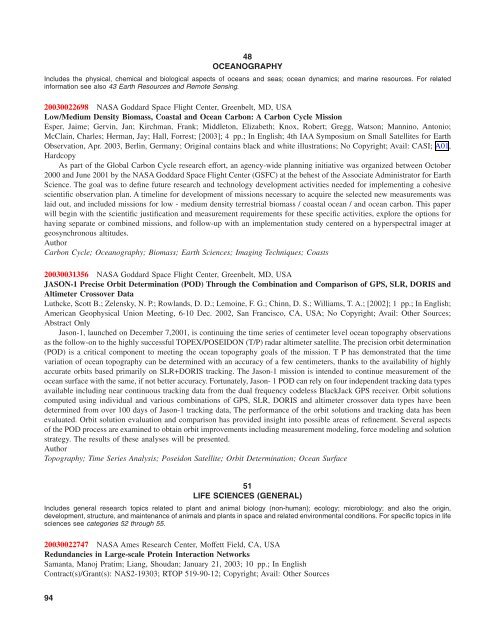You also want an ePaper? Increase the reach of your titles
YUMPU automatically turns print PDFs into web optimized ePapers that Google loves.
48<br />
OCEANOGRAPHY<br />
Includes the physical, chemical and biological aspects of oceans and seas; ocean dynamics; and marine resources. For related<br />
information see also 43 Earth Resources and Remote Sensing.<br />
20030022698 NASA Goddard Space Flight Center, Greenbelt, MD, USA<br />
Low/Medium Density Biomass, Coastal and Ocean Carbon: A Carbon Cycle Mission<br />
Esper, Jaime; Gervin, Jan; Kirchman, Frank; Middleton, Elizabeth; Knox, Robert; Gregg, Watson; Mannino, Antonio;<br />
McClain, Charles; Herman, Jay; Hall, Forrest; [2003]; 4 pp.; In English; 4th IAA Symposium on Small Satellites for Earth<br />
Observation, Apr. 2003, Berlin, Germany; Original contains black and white illustrations; No Copyright; Avail: CASI; A01,<br />
Hardcopy<br />
As part of the Global Carbon Cycle research effort, an agency-wide planning initiative was organized between October<br />
2000 and June 2001 by the NASA Goddard Space Flight Center (GSFC) at the behest of the Associate Administrator for Earth<br />
Science. The goal was to define future research and technology development activities needed for implementing a cohesive<br />
scientific observation plan. A timeline for development of missions necessary to acquire the selected new measurements was<br />
laid out, and included missions for low - medium density terrestrial biomass / coastal ocean / and ocean carbon. This paper<br />
will begin with the scientific justification and measurement requirements for these specific activities, explore the options for<br />
having separate or combined missions, and follow-up with an implementation study centered on a hyperspectral imager at<br />
geosynchronous altitudes.<br />
Author<br />
Carbon Cycle; Oceanography; Biomass; Earth Sciences; Imaging Techniques; Coasts<br />
20030031356 NASA Goddard Space Flight Center, Greenbelt, MD, USA<br />
JASON-1 Precise Orbit Determination (POD) Through the Combination and Comparison of GPS, SLR, DORIS and<br />
Altimeter Crossover Data<br />
Luthcke, Scott B.; Zelensky, N. P.; Rowlands, D. D.; Lemoine, F. G.; Chinn, D. S.; Williams, T. A.; [2002]; 1 pp.; In English;<br />
American Geophysical Union Meeting, 6-10 Dec. 2002, San Francisco, CA, USA; No Copyright; Avail: Other Sources;<br />
Abstract Only<br />
Jason-1, launched on December 7,2001, is continuing the time series of centimeter level ocean topography observations<br />
as the follow-on to the highly successful TOPEX/POSEIDON (T/P) radar altimeter satellite. The precision orbit determination<br />
(POD) is a critical component to meeting the ocean topography goals of the mission. T P has demonstrated that the time<br />
variation of ocean topography can be determined with an accuracy of a few centimeters, thanks to the availability of highly<br />
accurate orbits based primarily on SLR+DORIS tracking. The Jason-1 mission is intended to continue measurement of the<br />
ocean surface with the same, if not better accuracy. Fortunately, Jason- 1 POD can rely on four independent tracking data types<br />
available including near continuous tracking data from the dual frequency codeless BlackJack GPS receiver. Orbit solutions<br />
computed using individual and various combinations of GPS, SLR, DORIS and altimeter crossover data types have been<br />
determined from over 100 days of Jason-1 tracking data, The performance of the orbit solutions and tracking data has been<br />
evaluated. Orbit solution evaluation and comparison has provided insight into possible areas of refinement. Several aspects<br />
of the POD process are examined to obtain orbit improvements including measurement modeling, force modeling and solution<br />
strategy. The results of these analyses will be presented.<br />
Author<br />
Topography; Time Series Analysis; Poseidon Satellite; Orbit Determination; Ocean Surface<br />
51<br />
LIFE SCIENCES (GENERAL)<br />
Includes general research topics related to plant and animal biology (non-human); ecology; microbiology; and also the origin,<br />
development, structure, and maintenance of animals and plants in space and related environmental conditions. For specific topics in life<br />
sciences see categories 52 through 55.<br />
20030022747 NASA Ames Research Center, Moffett Field, CA, USA<br />
Redundancies in Large-scale Protein Interaction Networks<br />
Samanta, Manoj Pratim; Liang, Shoudan; January 21, 2003; 10 pp.; In English<br />
Contract(s)/Grant(s): NAS2-19303; RTOP 519-90-12; Copyright; Avail: Other Sources<br />
94
















